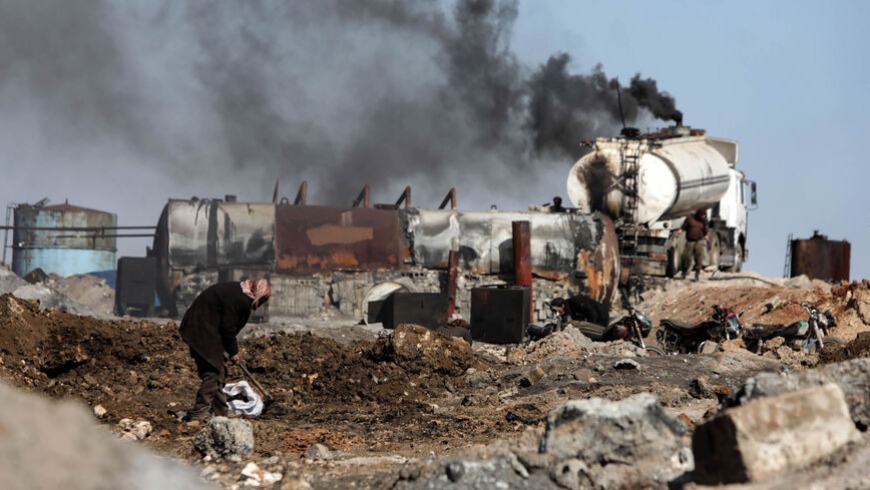The devastating impact of the war on the Syrian environment has been one of the lesser-discussed yet highly significant consequences of the ongoing conflict that started in 2011. While enforced disappearances, arbitrary detentions, massacres, forced displacement, and migration have garnered attention, environmental degradation has received insufficient notice despite its long-term implications. The severity of this crisis may even surpass that of the ongoing Syrian massacre.
Prior to the war, the systematic destruction of Syria’s natural environment had already begun, primarily driven by international companies. These companies forcefully replaced traditional, locally adapted seeds with hybrid varieties that were resistant to local pests but only produced crops once. This tactic ensured that Syrian farmers remained dependent on these companies for their seeds, further entangling the fate of the country’s agricultural sector with foreign interests.
How Many Syrians are on Board the Sunken Boat off Greek Coast?
The crisis of environmental degradation poses one of the most significant dangers to the Syrian people and their land. The repercussions will continue to affect multiple generations. The UNICEF report in 2023 highlighted that over half of Syria’s population was suffering from a lack of safe drinking water. The environmental situation in Syria deteriorated drastically between 2011 and 2023, with various forms of pollution becoming rampant.
Three major factors have contributed to this alarming situation. Firstly, there is a scarcity of water, accompanied by pollution and uncontrolled exploitation of water resources. The deliberate destruction during the war has damaged critical infrastructure and impeded the necessary maintenance of irrigation and water transport systems. Furthermore, there has been a complete disregard for water consumption rationalization, pollution prevention, and treatment to ensure its suitability for human use.
Even before 2011, numerous reports had already revealed the presence of serious diseases, particularly cancers, due to the consumption of polluted water that was mistakenly considered potable. However, medical specialists who spoke out about these disasters faced fierce security campaigns between 2000 and 2011. This period witnessed an alarming rise in various types of cancers in villages such as Tartous, Lattakia, and other Syrian towns. The neglect of regular maintenance led to the contamination of drinking water channels by sewage (“black water”).
The environmental crisis in Syria demands urgent attention, as its consequences will persist for years to come. Efforts should be made to restore and protect the natural environment, address water scarcity and pollution, and promote sustainable practices to safeguard the health and well-being of the Syrian people and the land they inhabit.
Soil erosion, pollution, and degradation have significantly impacted Syrian agricultural lands. United Nations reports indicate that by 2023, 75% of Syrian agricultural lands will experience a sharp decline in productivity due to mismanagement, over-exploitation, and the devastating consequences of the war. Factors such as continuous bombings, the control of armed forces, and the scorched-earth tactics employed by the Syrian regime have further exacerbated the situation. Research by PAX, a peace organization in the Netherlands, reveals that the concentration of heavy metals in Syrian soil today is 1000-2000% higher than pre-war levels, posing long-lasting effects that will impair soil productivity for decades.
Deforestation has also taken a heavy toll on Syria. The Food and Agriculture Organization (FAO) reported a 37% decrease in forest area between 2011 and 2013 alone due to unjust and continuous tree-cutting for fuel. Bombings have caused additional large-scale deforestation, with satellite images confirming the loss of nearly 60% of tree cover in Syria by 2023.
The environmental disasters resulting from the war in Syria are not limited to its borders. Their consequences will soon extend beyond, affecting neighbouring regions. Pollution, whether it is soil, air, or water-related, spreads rapidly and contagiously.
According to UNHCR, by 2023, one in three displaced Syrians will cite environmental degradation, along with conflict, as a reason for their displacement. The Institute for the Study of War (ISW) estimates a 150% increase in particulate matter (PM2.5) in Syria’s atmosphere between 2011 and 2023 due to thick clouds of smoke from burning oil wells and local refineries operated by militias using primitive methods. This has led to thousands of victims and the emergence of incurable diseases among the affected population.
The decline in environmental conditions has also had a severe impact on biodiversity. A 2023 report by the International Union for Conservation of Nature (IUCN) indicates that 35% of animal and plant species in Syria are at critical risk due to habitat loss caused by war activities, increased hunting, and poaching.
All these factors contribute to displacement, and addressing them requires urgent action. It is crucial to prioritize ending the war and working with international support to treat the environmental scars that will persist for decades. Strategies for future recovery and environmental rehabilitation should be developed, including cleaning polluted soil and restoring the green cover through reforestation to resist pollution and restore the natural balance of the land.
This article was translated and edited by The Syrian Observer. The Syrian Observer has not verified the content of this story. Responsibility for the information and views set out in this article lies entirely with the author.


